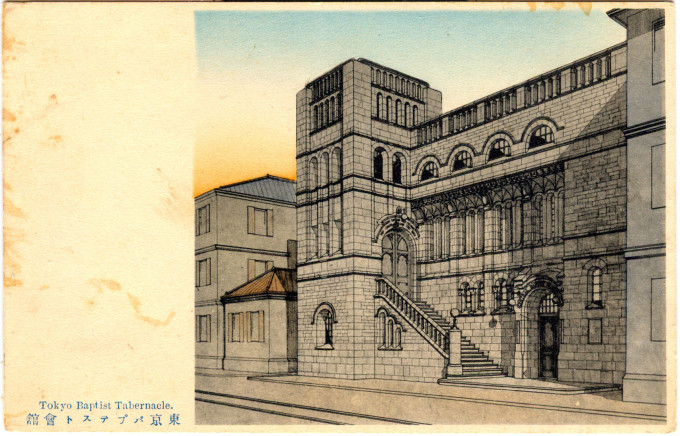“Built of a native material which makes it resemble the concrete block construction, in Cathedral form it presents an attractive appearance. The building itself will always be a silent witness to the Christ, commanding the attention of every passer-by.
“The outside dimensions are 96 feet for the length, with a width of 54 feet at the front and 36 feet in the rear. The height is 28 feet from the base of the foundation to the eaves plate.
“The interior is so arranged that the main building can be thrown into one auditorium seating some 1200 people. By means of folding and sliding doors it can be partitioned off so as to give rooms for various lines of work.
“… The 20th of September, 1908, was a happy day for Tokyo Baptists. They and their friends filled the spacious auditorium … Dr. A.A. Bennett, the veteran missionary, offered the dedicatory prayer. The dedication sermon was preached by Rev. Kame Yoshikawa, the Tabernacle pastor. His ringing message touched every heart … The girls of the Sarah Curtis Home and the boys of the Duncan Academy furnished the special music.”
– “The Central Tabernacle at Tokyo”, by Rev. Wm. Axling, The Baptist Missionary Magazine, June 1909

“Tokyo Baptist Tabernacle”, Kanda, Tokyo, c. 1910. Construction of the Tabernacle was completed in 1908 in the Misaki-cho neighborhood of Kanda just hwest of Suidobashi Station. Its solid masonry construction would prove fortuitous in the aftermath of the 1923 Great Kanto Earthquake when the Tabernacle’s large auditorium was turned into a makeshift hospital.
See also:
Sarah Curtis Home, Tokyo, c. 1910.
Duncan Academy, Tokyo, c. 1910.
Hiogo (Kobe) Baptist Church, c. 1910.
“At two minutes before noon on September first [1923], the eastern coast section of Japan, comprising the great cities of Tokyo, Yokohama, and Yokosuka, scores of towns, and hundreds of hamlets, was visited by one of the most violent earthquakes in history, followed by holocausts in each of the three cities. More than one half of Tokyo (over 400,000 houses) and nine-tenths of Yokohama were burned. The total loss of life in earthquake and fire will never be known, but is doubtless at least 100,000 lives. In Tokyo most of the strong Japanese churches were destroyed, and in Yokohama only two small church buildings remain.
“The Central Church had its home in the Misaki Tabernacle, our Christian community center in Kanda, which was gutted by the fire. This reinforced-concrete building can probably be restored, as the earthquake damage is relatively slight. Already it is serving as a distribution center for the needy hundreds resettling in the vast burned district. The story of the Tabernacle in the days after the earthquake is well known. Led by the Shinto priest from a neighboring shrine, young men cleared debris from the ruined structure and put it in shape to house refugees. A doctor, also a neighbor who had lost all, took charge of an emergency hospital and worked night and day till typhoid claimed him and ended his labors. His example and memory remain as lasting inspirations.
“Thruout these trying days for nearly a year, the building was home to hundreds’ of stricken refugees, and relief supplies to the value of thousands of dollars were distributed. Prince Tokugawa put at the disposal of the Tabernacle a fund of ¥30,000 for relief and rehabilitation.
“The foundation, walls, and roof, together with the frame, proved to be in excellent condition, having come thru the earthquake unharmed. The severe damage was entirely the result of the fire and the force of explosions in the nearby arsenal.”
– Japan Baptist Annual for 1924 and 1925

